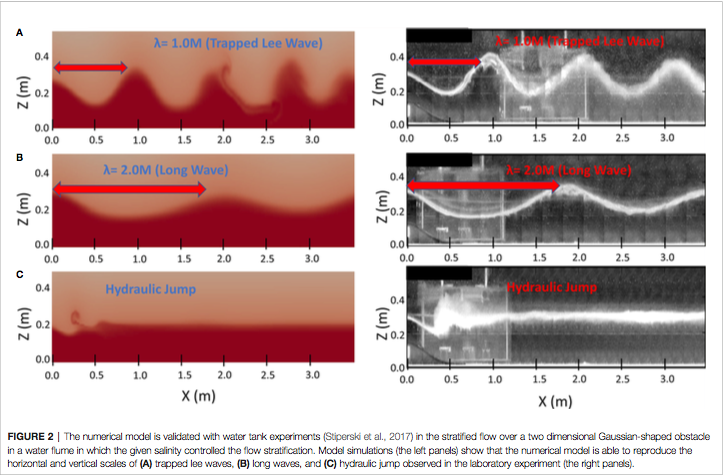
This work is licensed under a Creative Commons Attribution 4.0 International License
Wikipedia has an explanation of the hydraulic jump, mostly refering to hydraulic jumps in water.
An atmosheric hydraulic jump happens when there is a stratified atmospheric flow passing over an obstacle. For example a steady onshore wind coming from the Tasman Sea onto the South Island West Coast. This gives a warmer inland airmass behind the Southern Alps with the cooler onshore wind.
As the flow passes over the mountain it falls down the lee side because it is cooler (and denser) than the air in the lee side valley (which has been warming in the sun and has been protected from cooler flows).
The cool flow falls down the lee side in a thin fast laminar flow until it abruptly transitions into a thick slower turbulent flow.


This next image shows a numerical simulation next to observed data in a tank of fluid.

Often when we have a workable hydraulic jump there is a cap cloud on the mountain showing the thin fast flow and dissipating just before the transition to the thicker, slower flow. Sometimes you can see the lower edge of the cloud kicking up in the turbulence.
The lift is very close in and often you have to fly through severe turbulence to connect to the smooth lift ahead of the jump.
A classic place to connect to a hydraulic jump is The Wall, at the top of the Dobson. Another popular spot is the lee of Mt Sefton.
The wind speed required for a hydraulic jump seems to be less than that required for 'proper' lee wave, so you can get 'one bounce wave' where there is just a 'primary' wave bounce close in to the lee of a mountain.
If conditions favour good lee wave, there will often be a wave train triggered from the hydraulic jump.
Briefing prepared by Phil Plane.

This work is licensed under a Creative Commons Attribution 4.0 International License